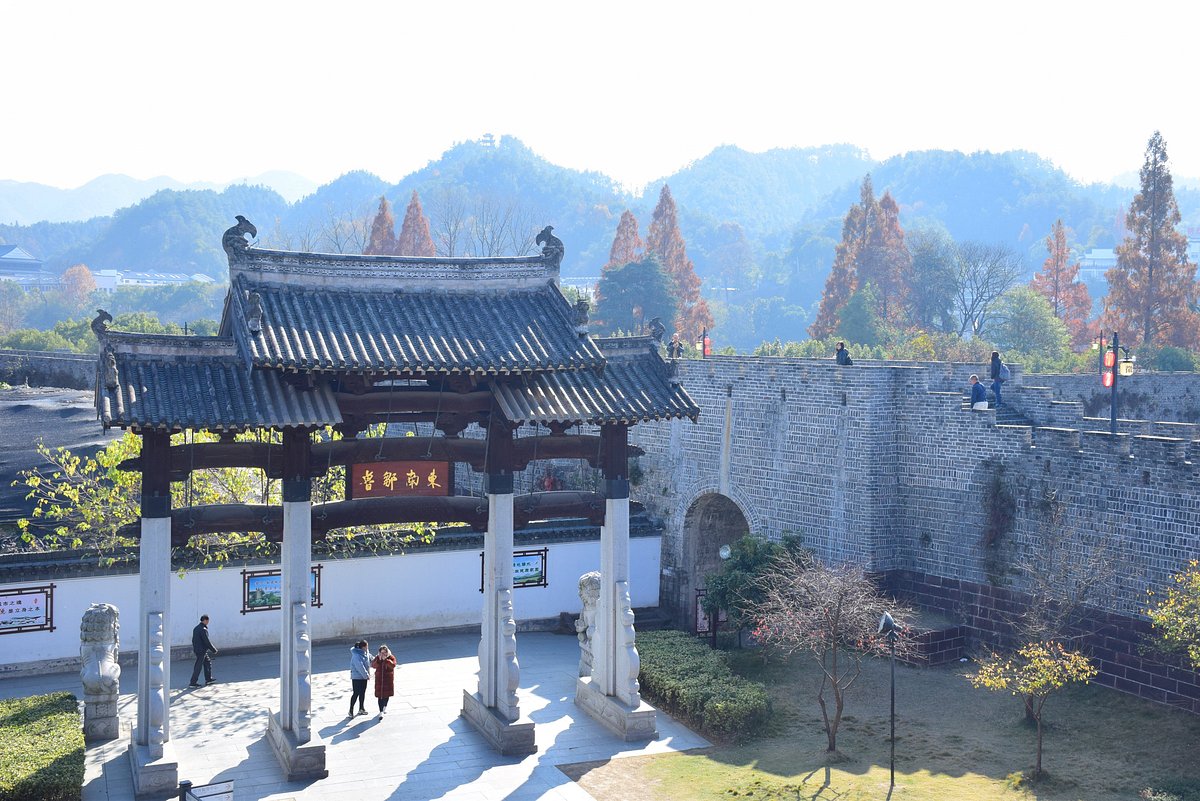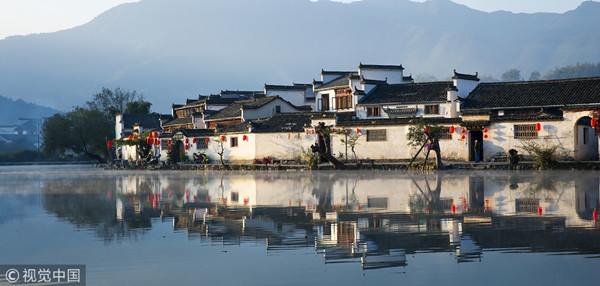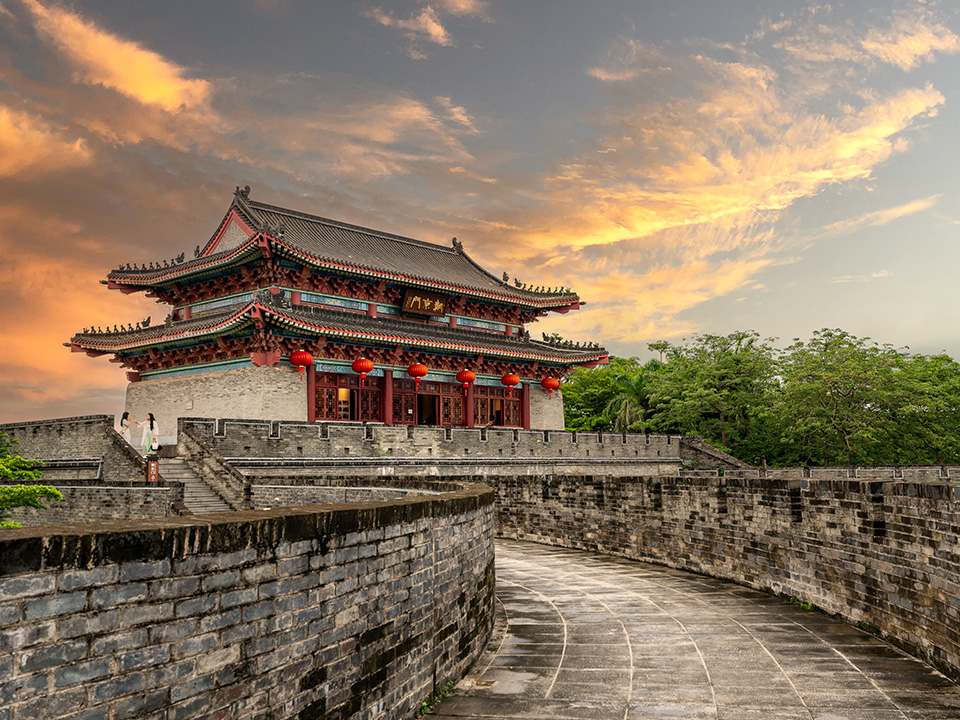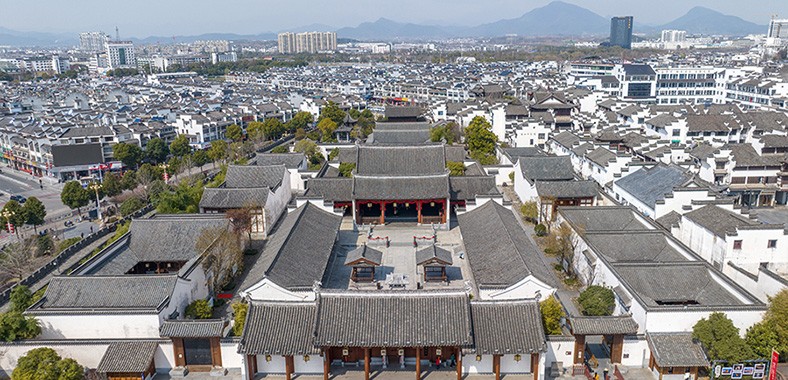Unveiling the Secrets of Ancient Huizhou: A Cultural Journey Through Time

An Essential Guide to Visiting Ancient Huizhou Cultural Tourism Area
Nestled in the enchanting landscapes of Anhui Province, the Ancient Huizhou Cultural Tourism Area beckons travelers with its rich tapestry of history, culture, and stunning architectural beauty. This timeless region, often referred to as the heart of Huizhou culture, is a treasure trove of Ming and Qing dynasty architecture, traditional crafts, and a profound philosophical heritage that has influenced generations.
As you wander through the cobbled streets of Huizhou Ancient City, you’ll be greeted by whitewashed walls adorned with intricate carvings, elegant stone archways, and charming teahouses that whisper stories of a bygone era. Each corner reveals the artistic legacy of Huizhou, from the serene paintings of the Xin An style to the captivating performances of Hui Opera, which have captivated audiences for centuries.
Beyond its architectural allure, the Ancient Huizhou Cultural Tourism Area is a living museum, offering an immersive experience into the philosophical teachings of Xin An Rationalism and the traditional crafts that have flourished in the region. Whether you’re exploring the majestic peaks and crystal-clear waters that frame this historic town or engaging with local artisans dedicated to preserving age-old practices, you’ll find that Huizhou is not just a destination—it’s a journey through time, where every moment is steeped in culture and history.
Prepare to be enchanted as you embark on an unforgettable adventure through one of China’s best-preserved ancient cities, where the essence of Huizhou culture continues to thrive amidst the whispers of history and the vibrancy of contemporary life.
In This Guide
- An Essential Guide to Visiting Ancient Huizhou Cultural Tourism Area
- The Rich History and Legends of Ancient Huizhou Cultural Tourism Area
- Main Highlights: What You Absolutely Can’t Miss
- Planning Your Visit: A Practical Guide
- Tickets: Prices, Booking, and Tips
- How to Get There: A Complete Transportation Guide
- Local Cuisine and Accommodation Nearby
- Frequently Asked Questions
- Final Thoughts on Your Trip
The Rich History and Legends of Ancient Huizhou Cultural Tourism Area
Nestled in the picturesque mountains of Anhui Province, the Ancient Huizhou Cultural Tourism Area echoes with the stories and legends of a bygone era. Rich in history and cultural significance, this area serves as a testament to the remarkable achievements of the Huizhou people over the centuries. The roots of this cultural haven can be traced back over a thousand years, when it emerged as a flourishing hub for trade, arts, and education during the Ming and Qing Dynasties.
At the heart of this captivating region lies Huizhou Ancient City, often regarded as a living museum of Huizhou culture. Its well-preserved architecture showcases the distinctive Han style that characterized the period, with whitewashed walls and elegant black-tiled roofs adorned with intricate carvings. As visitors stroll along the winding cobbled streets, they can’t help but feel a sense of connection to the past, where each corner turned reveals another piece of history waiting to be discovered.
The influence of Huizhou culture extends beyond its stunning architecture. It is recognized as a significant branch of Chinese culture, having made substantial contributions to philosophy, art, and literature. The development of Xin An Rationalism, a philosophical approach rooted in the teachings of Zhu Xi, reflects the intellectual spirit of the Huizhou people. This rationalist school emphasized moral integrity and academic rigor, shaping the ethical framework of the local community for centuries.
Art flourished in Huizhou as well, particularly through the emergence of Xin An Style Painting during the Ming Dynasty. This artistic genre celebrated the beauty of nature while advocating for a humble approach to creativity. The refined techniques of Huizhou Style Seal Cutting, pioneered by He Zhen during the same period, transformed the practice into a respected art form, elevating the standards of craftsmanship throughout China.
One cannot speak of Huizhou without mentioning Hui Opera, a mesmerizing performance art that rose to prominence in the Qing Dynasty. This unique opera genre, which blends elements of traditional Qin and Han tunes, continues to captivate audiences with its intricate storytelling and vibrant musicality. Hui Opera’s influence even reached the capital, contributing to the development of the iconic Peking Opera.
As you explore the Ancient Huizhou Cultural Tourism Area, be sure to visit the Xuguo Stone Archway, a remarkable structure that serves as a gateway to the city’s rich heritage. Each stone tells a story; each archway, a legend. From the enchanting landscapes to the historical artifacts, the area invites travelers to immerse themselves in the legacy of the Huizhou people.
In conclusion, the Ancient Huizhou Cultural Tourism Area is more than just a destination; it is a journey through time. Here, the remnants of a glorious past intertwine with the vibrant culture of the present, offering an unforgettable experience for those who seek to uncover the rich history and legends that have shaped this unique region of China. Whether you’re an avid history buff or simply curious about the cultural tapestry of this ancient city, Huizhou promises a captivating adventure that will leave a lasting impression.

Ancient Huizhou Cultural Tourism Area.
Main Highlights: What You Absolutely Can’t Miss
Nestled in the heart of Anhui Province, the Ancient Huizhou Cultural Tourism Area is a treasure trove of history, art, and architecture that beckons international travelers to explore its rich cultural heritage. Here are the must-see highlights that you absolutely cannot miss:
Huizhou Ancient City
A defining element of the region, Huizhou Ancient City is a beautifully preserved historical town that showcases the architectural styles of the Ming (1368-1644) and Qing (1644-1911) Dynasties. As you wander the winding cobblestone streets, you’ll encounter white-washed walls adorned with intricate carvings, elegant stone archways, and charming teahouses that evoke a sense of nostalgia. This area is often referred to as an “Exhibition of Huizhou Culture,” where every corner tells a story of the past.
Xuguo Stone Archway
One of the most iconic structures within Huizhou Ancient City, the Xuguo Stone Archway, also known as the East Triumphal Arch, is a stunning representation of traditional Chinese architecture. This grand archway, marked by its impressive stone carvings, serves as a gateway to the cultural richness of the Huizhou region. It stands as a testament to the artistic craftsmanship of the time and offers a picturesque spot for photography.
The Huizhou State Office
A historical gem, the Huizhou State Office has stood for over a millennium. It played a crucial role in local governance and is an essential stop for understanding the administrative history of Huizhou. The architecture reflects the grandeur of the era, and the site provides insights into the bureaucratic practices of ancient China.
Hui Opera
No visit to the Ancient Huizhou Cultural Tourism Area would be complete without experiencing Hui Opera, a unique form of traditional Chinese opera that originated from this region. Known for its melodious tunes and expressive storytelling, Hui Opera is deeply rooted in local culture and offers an enthralling performance that transports audiences to a different time and place. Look for local theaters showcasing this vibrant art form during your visit.
Huizhou Cultural Museums
Immerse yourself further into Huizhou’s rich heritage by visiting its various cultural museums. These establishments house collections of Xin An Rationalism, Xin An Style Painting, and Huizhou Style Seal Cutting, each illustrating the intellectual and artistic contributions of the Huizhou people throughout history. Learning about these genres will deepen your appreciation of the region’s cultural significance.
Scenic Surroundings
The natural beauty surrounding the Ancient Huizhou Cultural Tourism Area is nothing short of breathtaking. With rolling peaks and crystal-clear waters, the landscapes provide a serene backdrop to the historical sites. Take time to stroll along the ancient footbridges or relax by the pristine dams, allowing the picturesque scenery to enhance your cultural experience.
Local Cuisine
Finally, indulge your taste buds with Huizhou’s renowned cuisine. Make sure to try local specialties such as ‘Stinky Tofu’ and ‘Huizhou Braised Pork’ at one of the many traditional restaurants. The flavors here reflect the local culture and history, offering a delightful culinary experience that complements your exploration of the area.
These highlights represent just a glimpse of what the Ancient Huizhou Cultural Tourism Area has to offer. Whether you’re an avid history buff, an architecture enthusiast, or a cultural explorer, this captivating region promises an unforgettable journey into the heart of ancient Chinese civilization.

Ancient Huizhou Cultural Tourism Area.
Planning Your Visit: A Practical Guide
Exploring the Ancient Huizhou Cultural Tourism Area offers a unique glimpse into China’s rich history and cultural heritage. To make the most of your visit, here’s a practical guide that covers everything from the best times to visit to tips on transportation and local attractions.
Best Time to Visit
The ideal seasons to explore the Ancient Huizhou Cultural Tourism Area are spring (March to May) and summer (June to August). During these months, the weather is typically mild and pleasant, making your journey through the cobbled streets and traditional architecture more enjoyable. The vibrant greenery and blooming flowers also enhance the scenic beauty of the area.
Opening Hours and Ticket Information
The Huizhou Ancient City is open daily from 7:00 AM to 5:00 PM. Visiting is free, but note that there is a small fee of 48 RMB for entry to the Huizhou State Office, which is a key historical site within the area.
How to Get There
The Ancient Huizhou Cultural Tourism Area is located in Shexian County, Huangshan City in Anhui Province. Here are a few transportation options:
-
By Air: The nearest airport is Huangshan Tunxi International Airport, which is approximately 10 kilometers from the city center. From the airport, you can take a taxi or arrange a shuttle to your destination.
-
By Train: Huangshan City is well-connected by train. The Huangshan North Railway Station services high-speed trains from major cities such as Shanghai and Beijing. Once you arrive, local buses or taxis can take you to the Ancient Huizhou Cultural Tourism Area.
-
By Bus: Long-distance buses run from various cities to Shexian County. This option is budget-friendly and often gives you a chance to see more of the surrounding countryside.
Getting Around
Once you arrive in the Huizhou Ancient City, walking is the best way to explore. The area is pedestrian-friendly, and wandering through the narrow lanes will allow you to fully appreciate the ancient architecture and local culture. If you’re looking for a quicker way to get around, consider renting a bicycle or hiring a local guide who can provide insights into the history and significance of various sites.
Must-See Attractions
While visiting, don’t miss these highlights:
- Xuguo Stone Archway: An impressive structure that showcases traditional Huizhou architecture.
- Ancient Residences: Explore the beautifully preserved homes that reflect the rich history of the region.
- Teahouses: Experience traditional Huizhou culture by visiting a local teahouse to enjoy tea and snacks while soaking in the surroundings.
- Theatrical Stages: Discover the sites where local operas and performances take place, bringing Huizhou’s artistic heritage to life.
Local Cuisine
Indulge in the local flavors by trying Huizhou cuisine, known for its emphasis on fresh ingredients and rich flavors. Don’t miss out on dishes such as stewed bamboo shoots, smoked duck, and various dim sum. Local restaurants and street vendors offer a delightful array of options to satisfy your culinary curiosity.
Cultural Etiquette
As you explore the Ancient Huizhou Cultural Tourism Area, remember to respect local customs. Speak softly in public places, ask before taking photos of people, especially in traditional attire, and be mindful of the cultural significance of the sites you visit.
Practical Tips
- Language: While some locals may speak basic English, learning a few phrases in Mandarin can enhance your experience.
- Cash: Although digital payments are popular in China, it’s wise to carry some cash, particularly in smaller shops or markets.
- Stay Hydrated: Bring a water bottle to stay hydrated while exploring, especially during the warmer months.
Visiting the Ancient Huizhou Cultural Tourism Area is not just a journey through beautiful landscapes and historical sites, but an immersion into a vibrant culture that has thrived for centuries. Plan your visit wisely, and prepare to be enchanted by the enduring charm of Huizhou.

Ancient Huizhou Cultural Tourism Area.
Tickets: Prices, Booking, and Tips
When planning your visit to the Ancient Huizhou Cultural Tourism Area, understanding the ticketing details can enhance your experience and help you navigate your journey more smoothly. Here’s what you need to know:
Ticket Information
- General Admission: Entry to Huizhou Ancient City is free of charge, making it an accessible destination for all travelers. However, if you wish to visit the Huizhou State Office, a nominal fee of 48 RMB applies.
Booking Tips
- Advance Planning: Consider booking your tickets in advance if you are planning to join guided tours or special events within the area. While general admission is free, certain exhibitions or guided experiences may require prior reservation.
- Peak Seasons: The best time to visit is during spring and summer. However, these seasons can attract larger crowds. Arriving early in the day can help you avoid long lines and allow you to enjoy the serene beauty of the ancient architecture.
Additional Recommendations
- Duration of Visit: Allocate 2 to 3 hours to fully explore the site. This will give you ample time to wander through the charming cobbled streets, admire the intricate architecture, and soak in the rich cultural history.
- Accessibility: The site is open from 07:00 to 17:00 daily, so plan your visit accordingly to make the most of your time.
Contact Information
For further inquiries or tailored tour packages, you can reach out to local tour operators. Here are a couple of useful contacts:
– Phone: +86-28-85223672 / +86-28-85227275
– Email: [email protected] (replace with actual contact if needed)
By keeping these tips in mind, you can ensure a seamless and enriching experience as you delve into the ancient charm of Huizhou. Happy travels!
How to Get There: A Complete Transportation Guide
To reach the Ancient Huizhou Cultural Tourism Area, nestled in the picturesque Anhui Province of China, you’ll find several convenient transportation options that cater to international travelers. This guide outlines everything you need to know about getting there, ensuring a smooth journey to explore this remarkable destination steeped in history and culture.
By Air
Nearest Airport: Huangshan Tunxi International Airport (TXN)
Huangshan Tunxi International Airport is the closest airport to Huizhou Ancient City, located approximately 40 kilometers away. This airport has domestic flights from major cities such as Beijing, Shanghai, and Guangzhou.
- From the Airport to Huizhou Ancient City:
- Taxi: The most convenient option is to take a taxi directly to Huizhou Ancient City. The ride takes about 50 minutes and costs around 150-200 RMB.
- Airport Shuttle Bus: There are shuttle buses available that connect the airport to Huangshan city center. From there, you can take a local taxi or public transport to Huizhou Ancient City.
By Train
Train Stations: Huangshan North Railway Station
Huangshan North Railway Station is well-connected to several major cities in China via high-speed rail, making it an ideal entry point for travelers.
- From Major Cities:
- Shanghai to Huangshan: Approximately 4 hours by high-speed train.
- Beijing to Huangshan: Around 6 hours by high-speed train.
-
Hangzhou to Huangshan: About 2 hours by high-speed train.
-
From Huangshan North Railway Station to Huizhou Ancient City:
- Taxi: Taxis are readily available at the train station, and the trip to Huizhou Ancient City takes about 30-40 minutes, costing approximately 100-120 RMB.
- Public Transport: Buses are available but may require transfers, which can be less convenient for international travelers.
By Bus
Long-Distance Buses:
If you prefer road travel, long-distance buses operate from several nearby cities to Shexian County, where Huizhou Ancient City is located.
-
From Huangshan City:
Buses frequently depart from Huangshan’s central bus station to Shexian. The journey takes about 1 hour and costs around 20-30 RMB. -
From Other Cities:
Buses from cities like Nanjing, Suzhou, and Wuhan also service Shexian. Check local schedules for departure times and ticket prices.
By Car
Self-Driving:
For those who enjoy the freedom of the open road, renting a car is a viable option. The driving distance from Huangshan City to Huizhou Ancient City is about 40 kilometers, and the journey takes approximately 50 minutes.
- Navigation:
Make sure to use a GPS or a navigation app (like Baidu Maps or Gaode Maps) to guide you, as road signs may primarily be in Chinese.
Local Transportation
Once you arrive at Huizhou Ancient City, the area is best explored on foot. The charming cobbled streets and historical architecture make for a delightful walking experience. However, if you need to travel further afield, local taxis and electric buses are available.
Final Tips
- Language: English signage might be limited, so having a translation app on your phone can be helpful.
- Cash: While larger establishments may accept credit cards, it’s advisable to carry some cash (RMB) for smaller vendors.
- Timing Your Visit: The best time to visit is during the spring and summer months when the weather is pleasant for exploring.
With this transportation guide, you’re well-equipped to embark on your journey to the Ancient Huizhou Cultural Tourism Area, where centuries of history await your discovery. Enjoy your travels!

Ancient Huizhou Cultural Tourism Area.
Local Cuisine and Accommodation Nearby
When exploring the rich history of the Ancient Huizhou Cultural Tourism Area, indulging in local cuisine and finding the perfect place to stay can greatly enhance your experience. Here are some top recommendations for both food and accommodation that will allow you to fully immerse yourself in the culture and charm of this historic region.
Savor Local Flavors
1. Huizhou Cuisine at Hui Ren Restaurant
Located just a short walk from the Ancient City, Hui Ren Restaurant is renowned for its traditional Huizhou dishes. Here, you can try the famous Bamboo Rice—sticky rice infused with the essence of bamboo, or the delectable Braised Pork with Preserved Vegetables, a hearty dish that reflects the local flavors. The warm and welcoming atmosphere, combined with attentive service, ensures a delightful dining experience.
2. Teahouse Experience at Lao Huizhou Teahouse
For those looking to dive deeper into local culture, the Lao Huizhou Teahouse offers a unique experience. Enjoy a leisurely afternoon sipping on fragrant Huangshan green tea while sampling homemade pastries and tea eggs. This quaint teahouse, adorned with traditional décor, provides a serene environment to relax and soak in the local ambiance.
3. Street Food Adventures
Don’t miss out on the vibrant street food scene surrounding the Ancient City. Venture into the bustling alleyways to discover an array of snacks such as Stir-Fried Noodles and Spicy Grilled Fish Skewers. The local markets are also great for tasting Tangbao, steamed buns filled with flavorful broth and meat, making for a deliciously messy but memorable treat.
Comfortable Stays
1. Huangshan Huizhou Hotel**
This hotel combines modern comfort with traditional Huizhou architecture. Located conveniently near the Ancient City, it features spacious rooms adorned with local art and decor. Guests can enjoy a complimentary breakfast featuring local dishes before setting off to explore the historic area.
2. Hui Yuan Inn**
For a more intimate experience, consider staying at Hui Yuan Inn. This boutique guesthouse boasts exquisite wooden architecture and offers personalized service. Its tranquil courtyard is an ideal spot to unwind after a day of exploring, and the friendly staff can provide recommendations for local attractions and dining options.
3. Ancient City Guesthouse**
Perfect for budget travelers, the Ancient City Guesthouse offers cozy accommodations right at the heart of Huizhou. The guesthouse features dormitory-style rooms as well as private options, ensuring a comfortable night’s rest. With its communal kitchen and lounge areas, it’s a great place to meet fellow travelers.
Final Thoughts
Whether you’re indulging in Huizhou’s culinary delights or resting in one of its charming accommodations, your visit to the Ancient Huizhou Cultural Tourism Area promises to be a feast for the senses. Take the time to savor every bite and find comfort in the warm hospitality of this historical region.

Ancient Huizhou Cultural Tourism Area.
Frequently Asked Questions
Frequently Asked Questions about the Ancient Huizhou Cultural Tourism Area
1. What is the best time to visit the Ancient Huizhou Cultural Tourism Area?
The ideal times to visit are during spring (March to May) and summer (June to August). The weather during these seasons is pleasant, making it perfect for exploring the ancient city and its surroundings.
2. How much time should I allocate for a visit to Huizhou Ancient City?
A visit typically takes about 2 to 3 hours. This allows you to leisurely explore the ancient architecture, cobbled streets, and local attractions.
3. Are there any entrance fees for visiting Huizhou Ancient City?
Entry to Huizhou Ancient City is free; however, there is a small fee of 48 RMB to visit the Huizhou State Office, which is part of the cultural area.
4. What are the main attractions within the Ancient Huizhou Cultural Tourism Area?
Key attractions include the Xuguo Stone Archway, ancient residential dwellings, theatrical stages, teahouses, and the beautifully preserved architecture from the Ming and Qing Dynasties.
5. Is it easy to navigate the Ancient Huizhou Cultural Tourism Area?
Yes! The area is designed for walking, with winding cobbled lanes that guide you through the historical sites. Signage is available in both Chinese and English to help international travelers find their way.
6. Can I find local food and dining options while visiting?
Absolutely! There are numerous teahouses and local eateries within the area where you can enjoy traditional Huizhou cuisine and refreshments. Be sure to try some local snacks!
7. What should I wear when visiting Huizhou Ancient City?
Comfortable walking shoes are recommended, as you will be exploring cobblestone streets. Dress in layers to accommodate changing temperatures, especially if you visit during the cooler months.
8. Are there any guided tours available in the Ancient Huizhou Cultural Tourism Area?
Yes, guided tours are available and can provide deeper insights into the history and culture of Huizhou. You can opt for tailor-made tour packages that suit your preferences and interests.
Final Thoughts on Your Trip
As you reflect on your journey through the Ancient Huizhou Cultural Tourism Area, you’ll find that this enchanting region is more than just a collection of historic sites—it’s a vibrant tapestry of culture, history, and artistry woven through centuries. Walking the cobbled streets of Huizhou Ancient City, surrounded by elegant Ming and Qing Dynasty architecture, provides a unique glimpse into a past that continues to resonate today. The intricate carvings, serene teahouses, and lively theatrical stages tell stories of the Huizhou people’s profound contributions to philosophy, art, and performance.
Embrace the spirit of Huizhou culture as you explore the remarkable achievements in painting, rational thought, and traditional opera that have left an indelible mark on Chinese heritage. Each corner of this area reveals a new layer of history, inviting you to pause, reflect, and appreciate the artistry that has flourished here for generations.
Whether you were captivated by the exquisite craftsmanship of Huizhou-style seal cutting or enchanted by the melodious strains of Hui Opera, your experience will surely leave you with cherished memories and a deeper understanding of this unique cultural hub. As you prepare to leave, carry with you the essence of Huizhou—a place where the past beautifully intertwines with the present, ensuring that its stories continue to inspire travelers from around the globe.